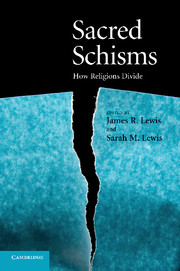Book contents
- Frontmatter
- Contents
- List of figures
- Notes on contributors
- Acknowledgments
- Introduction
- PART I THEORETICAL OVERVIEW
- 1 Understanding schisms: theoretical explanations for their origins
- PART II SURVEY OF SCHISMS IN SELECTED TRADITIONS
- PART III CHRISTIAN TRADITIONS
- PART IV WESTERN ESOTERIC TRADITIONS
- PART V NON-WESTERN/POSTCOLONIAL TRADITIONS
- Index
- References
1 - Understanding schisms: theoretical explanations for their origins
Published online by Cambridge University Press: 24 October 2009
- Frontmatter
- Contents
- List of figures
- Notes on contributors
- Acknowledgments
- Introduction
- PART I THEORETICAL OVERVIEW
- 1 Understanding schisms: theoretical explanations for their origins
- PART II SURVEY OF SCHISMS IN SELECTED TRADITIONS
- PART III CHRISTIAN TRADITIONS
- PART IV WESTERN ESOTERIC TRADITIONS
- PART V NON-WESTERN/POSTCOLONIAL TRADITIONS
- Index
- References
Summary
Since the dawn of the social sciences, scholars have written at length on the topic of schisms. The rich descriptions of Weber and Troeltsch, in particular, offered contrasts between the established churches and the sects they spawned. Each scholar pointed out stark differences in charismatic leadership, social class, asceticism, and soteriology. H. Richard Niebuhr (1929), though, was the first to inject theoretical life to the process of schism formation, explaining that sects arise to meet the religious needs of the “masses.” Niebuhr went on to explain that over time the more successful sects tend to be taken over by the privileged and are transformed into churches that no longer adequately serve the needs and tastes of the proletariat. Consequently, dissidents break away and yet another schism occurs. This gives rise to an endless cycle of transformations and schisms.
But a serious limitation of Niebuhr's model was that it relied almost entirely on class interests to explain schisms. There is no doubt that social class dynamics have contributed to many schisms, but an abundance of recent research has shown that social class differences are often not a motivating factor behind them. In fact, many of the most historically significant schisms, such as those producing the Essenes (Baumgarten 1997), the Christians (Stark 1996), and the Waldensians (Lambert 1977), were not based on the proletariat. A second limitation is that Niebuhr's model offers little explanation of the organizational dynamics underlying schisms or the larger context in which this process occurs.
- Type
- Chapter
- Information
- Sacred SchismsHow Religions Divide, pp. 11 - 34Publisher: Cambridge University PressPrint publication year: 2009
References
- 5
- Cited by



